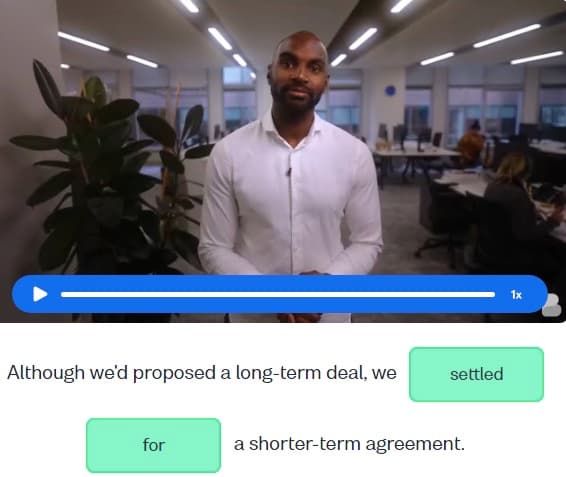I want to learn...
Author:

Barney Meekin
The best writing flows, with ideas seamlessly linking to the next. It uses words that guide readers from one idea or section to the next. Words that are like bridges, connecting thoughts so your readers never get lost.
These words are called transition — or linking — words. After reading this article, you’ll know all about transition words and how to use them in your written English.
What are transition words?
Transition words are words or phrases that link sentences, paragraphs, and ideas together, creating a smooth and logical flow. They’re present in all kinds of language. In casual conversation, people use basic transition words. But they really shine in written language.
English transition words (with example sentences)
Let’s take a look at the categories of transition words, their tone (formal, casual, or neutral), and some example sentences.
1. Additive transitions
Additive transition words are “and” words. Use these words when you want to add information or ideas.
Moreover (formal): "This research provides insights into climate change. Moreover, it suggests possible solutions."
Besides (neutral): "I don't feel like going out tonight. Besides, I have a lot of work to do."
Additionally (formal): "The maintenance team will look after the site on Market Street. Additionally, they will ensure it remains graffiti-free."
Plus (casual): "The hotel was beautiful. Plus, it was close to all major attractions."
As well as (neutral): "He's known for his research, as well as his teaching."
2. Adversative transitions
Adversative transition words are “but” words. Use these words when you want to show contrast.
However (formal): "The theory is plausible. However, it lacks empirical evidence."
On the other hand (casual): "I like the look of the red dress. On the other hand, the blue one is more comfortable."
Nevertheless (formal): "The experiment had limitations. Nevertheless, the results were significant."
Unlike (neutral): "Unlike you, I’ve never lived in a big city."
Although (neutral): "Although the weather is bad, the town is busy today."
3. Comparison and contrast transition words
Use comparison and contrast transition words to show the similarities and differences between two or more things.
Similarly (neutral): "The three brothers were similarly successful in their chosen careers."
Likewise (neutral): "I decided to cut sugar from my diet and my wife did likewise."
In contrast (neutral): "In contrast to last year's model, this version is much more energy efficient."
Conversely (formal): "The virus is spreading in urban areas. Conversely, rural areas are so far unaffected."
On the contrary (neutral): "He thought the task would be easy. On the contrary, he struggled to complete it."
4. Causal transitions
Causal transition words are “because” or “so” words. Use these words when you want to show cause-effect relationships.
Therefore (formal): "The data was incomplete. Therefore, we can’t rely on the results."
Due to (formal): "Due to the rainy weather, the sports day was canceled."
As a result (formal): "As a result of a major breakthrough in the research, new guidelines were established."
Thus (formal): "He failed to submit his application on time. Thus, he was not considered for the position."
Consequently (formal): "The company's profits dropped in the last quarter. Consequently, budget cuts were necessary."
5. Conditional transitions
Conditional transition words are “if” words. Use these words when you want to show conditions or hypothetical scenarios.
While (neutral): "While there’s life, there’s hope."
Provided that (formal): "Provided that your performance meets the set targets, you will receive a bonus."
Unless (casual): "We'll go to the beach unless it's too cold."
In case (formal): "In case of emergency, please follow the evacuation plan."
Suppose (casual): "Suppose we take a different route, would we save time?"
6. Transition words for giving examples or support
Use these transition words when you want to add examples or support to your ideas.
For instance (neutral): "Many animals hibernate. For instance, bears sleep through the winter."
Namely (formal): "They made several improvements to working conditions, namely increased wages and more paid leave days."
Such as (formal): "There are several options, such as renting or buying."
Like (casual): "I enjoy various sports, like basketball and tennis."
Including (formal): "The committee is made up of experts in the field, including two Nobel prize winners."
7. Time transition words
Use time transition words to show the times of events.
Afterward (casual): "We went for a walk and afterward, we had ice cream."
Subsequently (formal): "The law was passed. Subsequently, new regulations were implemented."
Meanwhile (casual): "Please set the table, and meanwhile, I’ll get the food ready."
Later (casual): "I'll call you later to discuss the details."
Eventually (formal): "Eventually, the company plans to expand into other markets."
8. Conclusion and summary transitions
Use these transition words when you want to summarize or conclude.
In conclusion (formal): "In conclusion, the results indicate more research into this topic is needed."
In summary (neutral): "In summary, it was a fantastic trip enjoyed by the whole family."
Ultimately (formal): "Ultimately, the final decision is the board’s."
All things considered (casual): "All things considered, I think we made a good decision."
To summarize (formal): "To summarize, to increase profits in the next quarter, a three-point plan will be implemented."
9. Emphasis transition words
Use these transition words when you want to show the importance of a point or idea.
Indeed (formal): "Indeed, this discovery could change our understanding of physics."
Above all (neutral): "Above all, remember to check and cite your sources before you submit the paper."
Especially (causal): "He was especially concerned about the impact the noise pollution was having on his daughters."
Notably (formal): "Notably, the study doesn’t give enough concrete implications for it to be useful."
Importantly (neutral): "Importantly, these changes will cause a delay."
How to use transition words correctly
Before you try to add words from this list it’s important to properly know how to use them. Follow these tips to make your writing (and speaking) clear and easy to understand.
Match the tone
You might think that by using the more formal — and complicated — linking words on this list, you’ll sound more intelligent. But you’re wrong. It’s important to match the tone to the situation. Use casual words in casual situations. Use formal words in academic and professional situations. And use neutral words in both.
When you communicate casually (speaking or writing), it’s okay to stick to the basics: “And,” “but,” “because,” “so,” and “if” are common for a reason. Everyone understands them and they’re useful in all situations — even academic or professional.
Here’s the takeaway: Use the basic linking words but sprinkle the formal words into your writing to add variety. But be careful when using formal linking words when speaking as it can alienate your listener.
Avoid using them too much
If you use too many linking words (especially the formal kind) your writing — or speaking — might seem unnatural. Linking words are there to make things clearer and easier to understand. When you use too many, it has the opposite effect.
The truth is, linking words are just one way (or cohesive device — to use their fancy name) to connect sentences, paragraphs, and ideas. Combine them with the following for best results:
Pronoun reference. Replace nouns with pronouns in following sentences. (“I saw John on Saturday. He didn’t look very well.”)
Substitution. To avoid repetition, rephrase words in following sentences. (“Before we go for dinner, you need to finish your homework. As soon as your assignment’s done we can go.”
Put them in the correct place
Although linking words can come at the beginning, middle, or end of a sentence, they’re most common at the beginning and middle. It can get a bit complicated so let’s look at the rules.
When you add one at the start of a sentence, follow it with a comma. But if the linking word has an object, put the comma after the object.
In the middle of a sentence, linking words usually follow a conjunction (like “and meanwhile”) or a semicolon (;). Our advice, forget the semicolon. Instead of using one, split the sentence into two sentences. It’s much clearer for your readers.
Transition words make your writing (and speaking) clear and natural
Transition words can make the difference between hard-to-understand and couldn’t-be-clearer language. Follow the tips in this guide the next time you need to write something, and your readers will be able to understand exactly what you’re saying. Remember to combine them with pronoun reference and substitution to give your writing a natural flow.
AUTHOR

Barney Meekin
Newlanguages


